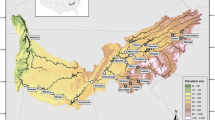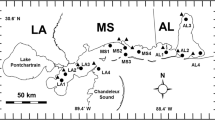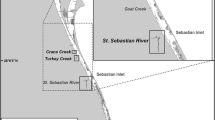Abstract
Shallow coastal systems act as nursery habitat for many species of fish and macroinvertebrates. Juveniles of these species may show selective use of certain habitat types over others, but the degree of such selectivity is not well studied for many species. Analysis of habitat selectivity is often hindered by inherently different gear types used in the habitats examined, which may not allow for direct comparison between the habitats. Here, we carry out nekton catches in the fringing marsh, using fyke nets, and in the adjacent seagrass habitat, using trawls, in the northern Gulf of Mexico to assess the relative use of the two habitats by the juveniles of six widespread important species. To resolve issues of gear comparability between fyke nets and trawls, we develop a habitat use index \(({HUI}_{S})\). The results reveal a consistent trend where, in relation to pinfish, speckled sea trout shows slightly higher (from 8.4 to 66.9 times); American silver perch and brown shrimp show moderately higher (from 2.3 to 369.4 times); and blue crab and white shrimp show greatly higher (from 90.6 to 2366.4 times) use of marsh over seagrass habitat. Thus, while similar in direction, differences in the use of marsh over seagrass habitat in relation to pinfish were more pronounced in some sites. We propose an index that can resolve issues of gear comparability and improve our understanding of coastal habitat selectivity by fish and macroinvertebrates.







Similar content being viewed by others
Data Availability
Data are available upon request to the authors.
References
Able, K.W. 2005. A re-examination of fish estuarine dependence: Evidence for connectivity between estuarine and ocean habitats. Estuarine, Coastal and Shelf Science 64 (1): 5–17.
Anton, A., J. Cebrian, K. Heck, C.M. Duarte, and J. Goff. 2009. Low impact of Hurricane Katrina on seagrass community structure and functioning in the Northern Gulf of Mexico. Bulletin of Marine Science 85: 45–59.
Anton, A., J. Cebrian, K. Heck, C.M. Duarte, K.L. Sheehan, M. Miller, and C.D. Foster. 2011. Decoupled effects (positive to negative) of nutrient enrichment on ecosystem services. Ecological Applications 21: 991–1009.
Baker, R., and T.J. Minello. 2011. Trade-offs between gear selectivity and logistics when sampling nekton from shallow open water habitats: A gear comparison study. Gulf and Caribbean Research 23 (1): 37–48.
Bohaboy, E.C., W.F. Patterson and J. Mareska. 2018. Stock assessment of spotted seatrout (Cynoscion nebulosus, Sciaenidae) in Alabama. Alabama Department of Conservation and Natural Resources, Marine Resource Division, Gulf Shores, Alabama, 61 pp.
Brown-Peterson, N.J., and J.W. Warren. 2001. The reproductive biology of spotted seatrout, Cynoscion nebulosus, along the Mississippi Gulf Coast. Gulf of Mexico Science 19 (1): 61–73.
Castellanos, D.L., and L.P. Rozas. 2001. Nekton use of submerged aquatic vegetation, marsh, and shallow unvegetated bottom in the Atchafalaya River Delta, a Louisiana tidal freshwater ecosystem. Estuaries 24 (2): 184–197.
Cebrian, J. 2002. Variability and control of carbon consumption, export, and accumulation in marine communities. Limnology and Oceanography 47: 11–22.
Cebrian, J., H. Liu, M. Christman, T. Hollweg, D. French-McCay, R. Balouskus, C. McManus, H. Ballesteros, J. White, S. Friedman, and K. Benson. 2020. Standardizing estimates of biomass at recruitment and productivity for fin- and shellfish in coastal habitats. Estuaries and Coasts. https://doi.org/10.1007/s12237-019-00691-2.
Colombano, D., S.Y. Litvin, S.L. Ziegler, S.B. Alford, R. Baker, M.A. Barbeau, J. Cebrian, R.M. Conolly, C.A. Currin, L. Deegan, J.S. Lesser, C.W. Martin, A.E. McDonald, C. McLuckie, B.H. Morrison, J.W. Pahl, L. Mark Risse, J.A.M. Smith, L.W. Staver, R.E. Turner, and N.J. Waltham. 2021. Climate change implications for tidal marshes and food web linkages to estuarine and coastal nekton. Estuaries and Coasts. https://doi.org/10.1007/s12237-020-00891-1.
Dunton, K.H. 1990. Production Ecology of Ruppia maritima LS1 and Halodule wrightii Aschers in 2 subtropical estuaries. Journal of Experimental Marine Biology and Ecology 143: 147–164.
Flaherty-Walia, K.E., R.E. Matheson, and R. Paperno. 2015. Juvenile spotted seatrout (Cynoscion nebulosus) habitat use in an Eastern Gulf of Mexico Estuary: The effects of seagrass bed architecture, seagrass species composition, and varying degrees of freshwater influence. Estuaries and Coasts 38: 353–366.
Gilby, B.L., M.P. Weinstein, R. Baker, J. Cebrian, S.B. Alford, A. Chelsky, D. Colombano, R.M. Connolly, C.A. Currin, I.C. Feller, A. Frank, J.A. Goeke, L.A. Goodridge Gaines, F.E. Hardcastle, C.J. Henderson, C.W. Martin, A.E. McDonald, B.H. Morrison, A.D. Olds, J.S. Rehage, N.J. Waltham, and S.L. Ziegler. 2020. Human actions alter tidal marsh seascapes and the provision of ecosystem services. Estuaries and Coasts. https://doi.org/10.1007/s12237-020-00830-0.
Grammer, G.L., N.J. Brown-Peterson, M.S. Peterson, and B.H. Comyns. 2009. Life history of Silver Perch Bairdiella chrysoura (Lacepède, 1803) in North-Central Gulf of Mexico Estuaries. Gulf of Mexico Science 27 (1): 62–73.
Heck, K.L., Jr., G. Hays, and R.J. Orth. 2003. Critical evaluation of the nursery role hypothesis for seagrass meadows. Marine Ecology Progress Series 253: 123–136.
Hettler, W.F., Jr. 1989. Nekton use of regularly-flooded saltmarsh cordgrass habitat in North Carolina, USA. Marine Ecology Progress Series 56: 111–118.
Hines A.H. 2007. Biology of the blue crab. In Ecology of juvenile and adult blue crabs, eds. V.S.
Hollweg, T.A., M.C. Christman, J. Cebrian, B.P. Wallace, S.L. Friedman, H.R. Ballestero, M.T. Huisenga, and K.G. Benson. 2019. Meta-analysis of nekton utilization of coastal habitats in the northern Gulf of Mexico. Estuaries and Coasts. https://doi.org/10.1007/s12237-019-00633-y.
Lassuy D.R. 1983. Species profiles: life histories and environmental requirements (Gulf of Mexico): Brown shrimp. U.S. Fish and Wildlife Services Biological Report 82(11.1). US Army Corps of Engineers, TR EL 82 (4): 1–15.
Lefcheck, J. S., B. B. Hughes, A. J. Johnson, B. W. Pfirrmann, D. B. Rasher, A. R. Smyth, B. L. Williams, M. W. Beck and R. J. Orth. 2019. Are coastal habitats important nurseries? A meta-analysis. Conservation Letters. https://doi.org/10.1111/conl.12645
Lycett, K.A., J.D. Shields, J.S. Chung, and J.S. Pitula. 2020. Population structure of the blue crab Callinectes sapidus in the Maryland Coastal Bays. Journal of Shellfish Research 39 (3): 699–713.
McDonald, R.B., R.M. Moody, K.L. Heck, and J. Cebrian. 2016. Fish, macroinvertebrate and epifaunal communities in shallow coastal lagoons with varying seagrass cover of the northern Gulf of Mexico. Estuaries and Coasts 39: 718–730.
McIvor, C.C., and W.E. Odum. 1988. Food, predation risk, and microhabitat selection in a marsh fish assemblage. Ecology 69 (5): 1341–1351.
McMichael, R.H., Jr. and K.M. Peters. 1989. Early life history of spotted seatrout, Cynoscion nebulosus (Pisces: Sciaenidae), in Tampa Bay, Florida. Estuaries 12: 98–110.
Minello, T.J., and L.P. Rozas. 2002. Nekton in Gulf Coast wetlands: Fine-scale distributions, landscape patterns, and restoration implications. Ecological Applications 12 (2): 441–455.
Minello, T.J., K.W. Able, M.P. Weinstein, and C.G. Hays. 2003. Salt marshes as nurseries for nekton: Testing hypotheses on density, growth and survival through meta-analysis. Marine Ecology Progress Series 246: 39–59.
Monczak, A., B. McKinney, J. Souiedan, A.D. Marian, A. Seder, E. May, T. Morgenstern, W. Roumillat, and E.W. Montie. 2022. Sciaenid courtship sounds correlate with juvenile appearance and abundance in the May River, South Carolina, USA. Marine Ecology Progress Series 693: 1–17.
Moody, R.M., J. Cebrian, and K.L. Heck Jr. 2013. Interannual recruitment dynamics for resident and transient marsh species: Evidence for a lack of impact by the Macondo oil spill. PLoS ONE 8 (3): e58376. https://doi.org/10.1371/journal.pone.0058376.
Nelson, G.A. 1998. Abundance, growth, and mortality of young-of-the-year pinfish, Lagodon rhomboides, in three estuaries along the gulf coast of Florida. Fishery Bulletin 96: 315–328.
Nelson, G.A. 2002. Age, growth, mortality, and distribution of pinfish (Lagodon rhomboides) in Tampa Bay and adjacent Gulf of Mexico waters. Fishery Bulletin 100: 582–592.
Paterson, A.W., and A.K. Whitfield. 2000. The ichthyofauna associated with an intertidal creek and adjacent eelgrass beds in the Kariega Estuary, South Africa. Environmental Biology of Fishes 58: 145–156.
Renfro, W.C. and Brusher, H.A. (1982). Seasonal abundance, size distribution, and spawning of three shrimps (Penaeus aztecus, P. setiferus, and P. duorarum) in the northwestern Gulf of Mexico, 1961- 1962. (NOAA Tech. Memo. No. NMFS-SEFC-94) (p. 47).
Rodriguez, C., and A.W. Stoner. 1990. The epiphyte community of mangrove roots in a tropical estuary: Distribution and biomass. Aquatic Botany 36: 117–126.
Rozas, L.P., and T.J. Minello. 1997. Estimating densities of small fishes and decapod crustaceans in shallow estuarine habitats: A review of sampling design with focus on gear selection. Estuaries 20 (1): 199–213.
Rozas, L.P., and R.J. Zimmerman. 2000. Small-scale patterns of nekton use among marsh and adjacent shallow non-vegetated areas of the Galveston Bay estuary, Texas (USA). Marine Ecology Progress Series 193: 217–239.
Rozas, L.P., T.J. Minello, R.J. Zimmerman, and P. Caldwell. 2007. Nekton populations, long-term wetland loss, and the effect of recent habitat restoration in Galveston Bay, Texas, USA. Marine Ecology Progress Series 344: 119–130.
Rozas, L.P., T.J. Minello, and D.D. Dantin. 2012. Use of shallow lagoon habitats by nekton of the Northeastern Gulf of Mexico. Estuaries and Coasts 35: 572–586.
Rutherford, E., E. Thue, and D. Buker. 1982. Population characteristics, food habits, and spawning activity of spotted seatrout, Cynoscion nebulosus, in Everglades National Park, Florida. South Fla Res Cent Rep T-668. 48 pp.
Scheffel, W.A., K.L. Heck, and M.W. Johnson. 2018. Tropicalization of the northern Gulf of Mexico: Impacts of salt marsh transition to black mangrove dominance on faunal communities. Estuaries and Coasts 41: 1193–1205.
Sharma, S., J. Goff, J. Cebrian, and C. Ferraro. 2016. A hybrid shoreline stabilization technique: Impact of modified intertidal reefs on marsh expansion and nekton habitat in the northern Gulf of Mexico. Ecological Engineering 90: 352–360.
Sheaves, M., R. Baker, I. Nagelkerken, and R.M. Connolly. 2015. True value of estuarine and coastal nurseries for fish: Incorporating complexity and dynamics. Estuaries and Coasts 38: 401–414.
Shervette, V.R., and F. Gelwick. 2008. Seasonal and spatial variations in fish and macroinvertebrate communities of oyster and adjacent habitats in a Mississippi estuary. Estuaries and Coasts 31 (3): 584–596.
Shervette, V.R., F. Gelwick, and N. Hadley. 2011. Decapod utilization of adjacent oyster, vegetated marsh, and non-vegetated bottom habitats in a Gulf of Mexico estuary. Journal of Crustacean Biology 31 (4): 660–667.
Shipp, R. L. 2012. Dr. Bob Shipp’s guide to fishes of the Gulf of Mexico. Kme Seabooks (2nd edition), Mobile, Alabama (USA), 250 pp
Stoner, A.W. 1983. Distribution of fishes in seagrass meadows: Role of macrophyte biomass and species composition. Fishery Bulletin 81: 837–846.
VanderKooy, S. (Editor). 2013. GDAR 01 Stock assessment report gulf of mexico blue crab. GSMFC Number 215, Gulf Data, Assessment, and Review. Gulf States Marine Fisheries Commission, 2404 Government Street, Ocean Springs, MS 39564
Zu Ermgassen, P.S.E, B. DeAngelis, J.R. Gair, S. Zu Ermgassen, R. Baker, A. Daniels, T.C. MacDonald, K. Meckley, S. Powers, M. Ribera, L.P. Rozas and J. H. Grabowski. 2021. Estimating and applying fish and invertebrate density and production enhancement from seagrass, salt marsh edge, and oyster reef nursery habitats in the Gulf of Mexico. https://doi.org/10.1007/s12237-021-00935-0
Acknowledgements
We thank the many interns, students, and other personnel who helped with the sampling, particularly L. Biermann, J. Goff, J. Gulbranson, J. Hemphill, J. Howard, J. Kay, S. Kerner, A. Macy, M. Metcalf, J. Reynolds, A. Schat, L. Schumacher, S. Sharma, K. Watson, and D. Byron. Two anonymous reviewers provided comments that benefited the document.
Funding
This work was made possible by grants from British Petroleum made to the Marine Environmental Science Consortium and the Northern Gulf Institute and from the National Oceanic and Atmospheric Administration (NOAA RESTORE NA19NOS4510194) made to the Northern Gulf Institute.
Author information
Authors and Affiliations
Corresponding author
Ethics declarations
Just Cebrian is an Associate Editor for the journal “Estuaries and Coasts”.
Additional information
Communicated by Masahiro Nakaoka
Supplementary Information
Below is the link to the electronic supplementary material.
Rights and permissions
Springer Nature or its licensor (e.g. a society or other partner) holds exclusive rights to this article under a publishing agreement with the author(s) or other rightsholder(s); author self-archiving of the accepted manuscript version of this article is solely governed by the terms of such publishing agreement and applicable law.
About this article
Cite this article
Cebrian, J., Gilpin, R., Alberti, J. et al. Comparing Shallow Seagrass Versus Fringing Marsh Habitat Use by Nekton Juvenile Recruits with “Incomparable” Fishing Gear in the Northern Gulf of Mexico. Estuaries and Coasts 47, 839–850 (2024). https://doi.org/10.1007/s12237-024-01324-z
Received:
Revised:
Accepted:
Published:
Issue Date:
DOI: https://doi.org/10.1007/s12237-024-01324-z




